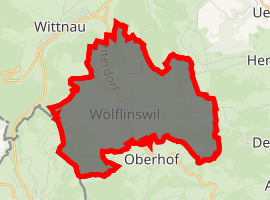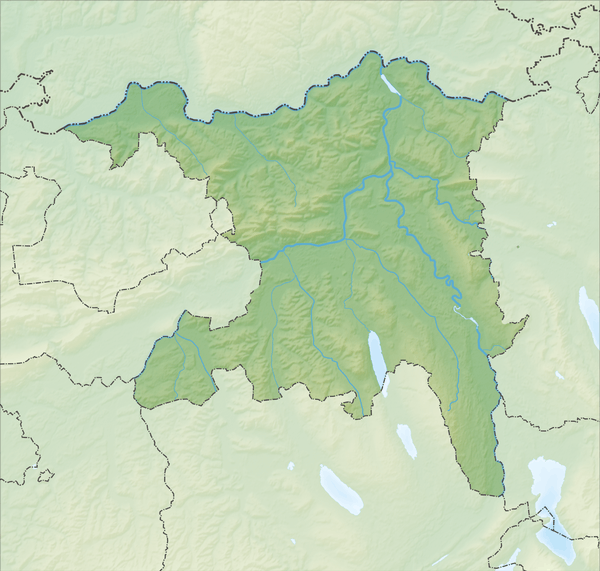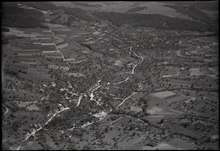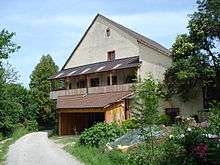Wölflinswil
Wölflinswil is a municipality in the district of Laufenburg in the canton of Aargau in Switzerland.
Wölflinswil | |
|---|---|
 | |
 Coat of arms | |
Location of Wölflinswil 
| |
 Wölflinswil  Wölflinswil | |
| Coordinates: 47°28′N 8°0′E | |
| Country | Switzerland |
| Canton | Aargau |
| District | Laufenburg |
| Area | |
| • Total | 9.51 km2 (3.67 sq mi) |
| Elevation | 437 m (1,434 ft) |
| Population (2018-12-31)[2] | |
| • Total | 1,048 |
| • Density | 110/km2 (290/sq mi) |
| Postal code | 5063 |
| SFOS number | 4182 |
| Surrounded by | Densbüren, Gipf-Oberfrick, Herznach, Kienberg (SO), Oberhof, Wittnau |
| Website | www SFSO statistics |
Geography

Wölflinswil has an area, as of 2009, of 9.51 square kilometers (3.67 sq mi). Of this area, 5.92 km2 (2.29 sq mi) or 62.3% is used for agricultural purposes, while 2.95 km2 (1.14 sq mi) or 31.0% is forested. Of the rest of the land, 0.61 km2 (0.24 sq mi) or 6.4% is settled (buildings or roads), 0.01 km2 (2.5 acres) or 0.1% is either rivers or lakes.[3]
Of the built up area, housing and buildings made up 3.9% and transportation infrastructure made up 2.0%. Out of the forested land, 28.9% of the total land area is heavily forested and 2.1% is covered with orchards or small clusters of trees. Of the agricultural land, 39.4% is used for growing crops and 18.2% is pastures, while 4.6% is used for orchards or vine crops. All the water in the municipality is in rivers and streams.[3]
Coat of arms
"The blazon of the municipal coat of arms is Or a Wolf Gules passant regardant. The wolf is an example of canting.[4]"
Demographics
Wölflinswil has a population (as of December 2018) of 1,049[5] As of June 2009, 5.0% of the population are foreign nationals.[6] Over the last 10 years (1997–2007) the population has changed at a rate of 5.1%. Most of the population (as of 2000) speaks German (96.2%), with Albanian being second most common ( 1.8%) and Serbo-Croatian being third ( 0.6%).[7]
The age distribution, as of 2008, in Wölflinswil is; 115 children or 12.7% of the population are between 0 and 9 years old and 110 teenagers or 12.1% are between 10 and 19. Of the adult population, 109 people or 12.0% of the population are between 20 and 29 years old. 123 people or 13.5% are between 30 and 39, 159 people or 17.5% are between 40 and 49, and 111 people or 12.2% are between 50 and 59. The senior population distribution is 108 people or 11.9% of the population are between 60 and 69 years old, 36 people or 4.0% are between 70 and 79, there are 33 people or 3.6% who are between 80 and 89,and there are 5 people or 0.6% who are 90 and older.[8]
As of 2000, there were 17 homes with 1 or 2 persons in the household, 119 homes with 3 or 4 persons in the household, and 148 homes with 5 or more persons in the household.[9] As of 2000, there were 294 private households (homes and apartments) in the municipality, and an average of 2.7 persons per household.[7] In 2008 there were 176 single family homes (or 51.8% of the total) out of a total of 340 homes and apartments.[10] There were a total of 3 empty apartments for a 0.9% vacancy rate.[10] As of 2007, the construction rate of new housing units was 14.9 new units per 1000 residents.[7]
In the 2007 federal election the most popular party was the SVP which received 44.9% of the vote. The next three most popular parties were the CVP (21%), the SP (10.2%) and the FDP (7.1%).[7]
In Wölflinswil about 75.8% of the population (between age 25-64) have completed either non-mandatory upper secondary education or additional higher education (either university or a Fachhochschule).[7] Of the school age population (in the 2008/2009 school year), there are 81 students attending primary school in the municipality.[9]
The historical population is given in the following table:[8]
| Year | Pop. | ±% |
|---|---|---|
| 1975 | 739 | — |
| 1980 | 753 | +1.9% |
| 1990 | 739 | −1.9% |
| 2000 | 810 | +9.6% |
Sights

The village of Wölflinswil is designated as part of the Inventory of Swiss Heritage Sites.[11]
Economy
As of 2007, Wölflinswil had an unemployment rate of 1.63%. As of 2005, there were 110 people employed in the primary economic sector and about 37 businesses involved in this sector. 57 people are employed in the secondary sector and there are 8 businesses in this sector. 104 people are employed in the tertiary sector, with 23 businesses in this sector.[7]
In 2000 there were 429 workers who lived in the municipality. Of these, 291 or about 67.8% of the residents worked outside Wölflinswil while 71 people commuted into the municipality for work. There were a total of 209 jobs (of at least 6 hours per week) in the municipality.[12] Of the working population, 14.2% used public transportation to get to work, and 45% used a private car.[7]
Wölflinswil has a kindergarten and a primary school. Sekundarschule and Realschule can be attended in Gipf-Oberfrick and Bezirksschule in Frick. The nearest Kantonsschule is in Aarau.
Religion
From the 2000 census, 529 or 67.5% were Roman Catholic, while 138 or 17.6% belonged to the Swiss Reformed Church. Wölflinswil has one Catholic Church. Of the rest of the population, there was 1 individual who belonged to the Christian Catholic faith.[9]
References
- "Arealstatistik Standard - Gemeinden nach 4 Hauptbereichen". Federal Statistical Office. Retrieved 13 January 2019.
- "Ständige Wohnbevölkerung nach Staatsangehörigkeitskategorie Geschlecht und Gemeinde; Provisorische Jahresergebnisse; 2018". Federal Statistical Office. 9 April 2019. Retrieved 11 April 2019.
- Swiss Federal Statistical Office-Land Use Statistics 2009 data (in German) accessed 25 March 2010
- Flags of the World.com accessed 10-May-2010
- Swiss Federal Statistical Office - STAT-TAB, online database – Ständige und nichtständige Wohnbevölkerung nach institutionellen Gliederungen, Geburtsort und Staatsangehörigkeit (in German) accessed 23 September 2019
- Statistical Department of Canton Aargau -Bereich 01 -Bevölkerung (in German) accessed 20 January 2010
- Swiss Federal Statistical Office accessed 10-May-2010
- Statistical Department of Canton Aargau -Bevölkerungsdaten für den Kanton Aargau und die Gemeinden (Archiv) (in German) accessed 20 January 2010
- Statistical Department of Canton Aargau - Aargauer Zahlen 2009 (in German) accessed 20 January 2010
- Statistical Department of Canton Aargau (in German) accessed 20 January 2010
- ISOS site accessed 10-May-2010
- Statistical Department of Canton Aargau-Bereich 11 Verkehr und Nachrichtenwesen (in German) accessed 21 January 2010
| Wikimedia Commons has media related to Wölflinswil. |